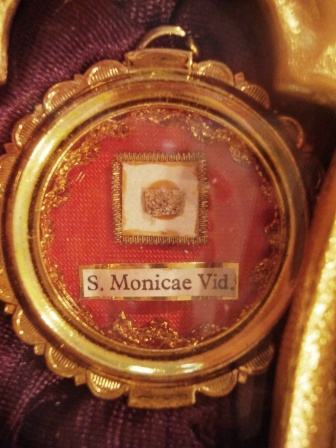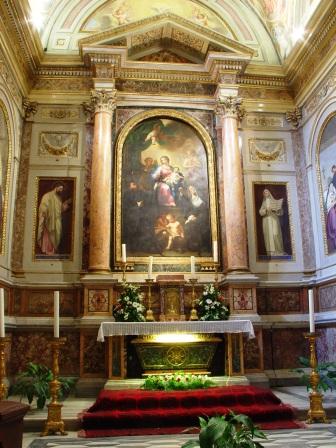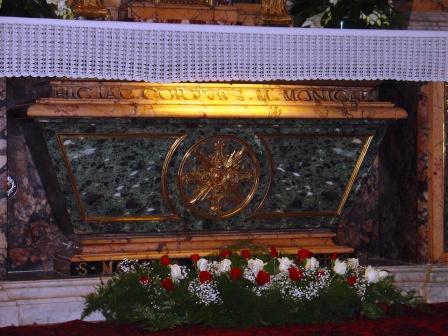Here is an oldie post, appropriate for the day:
Today in newer, Ordinary Form calendar of the Holy Roman Church is the feast of St. Monica, the mother of St. Augustine of Hippo. In the traditional calendar her feast was back in May.
Her name, which is Punic in origin, is also properly spelled Monnica.
This is the chapel in the church of St. Augustine in Rome where the mortal remains of St. Monica (+387), the mother of Augustine of Hippo now rest.
To the right is a shot of the chapel on the day some years ago when the bones of her son, St. Augustine, were brought from their resting place in Pavia (near Milan) to Rome.
How did St. Monica’s tomb wind up here?
Here is an excerpt from an article I wrote for Inside the Vatican (December 2004) on the above mentioned event. I used the alternate (and more accurate Punic) spelling of the saint’s name – “Monnica” (emphasis not in the original):
Most visitors to the Eternal City find it puzzling and wondrous that Monnica’s remains would be in Rome and even more so that Augustine’s should be in northern Italy, or that we have them at all. How did this come to pass? Monnica died at age 56 of a malarial fever at Ostia, Rome’s port city, not far from where modern Rome’s port, DaVinci airport, is situated.
After Augustine’s baptism in 386 by Milan’s bishop St. Ambrose (+ AD 397), Monnica and Augustine together with his brother Navigius, Adeodatus the future bishop’s son by his concubine of many years whom Monnica had forced Augustine to put aside, and friends Nebridius, Alypius and the former Imperial secret service agent (agens in rebus) Evodius were all waiting at Ostia to return home to Africa by ship. They were stuck there for some time because the port was blockaded during a period of civil strife.
As she lay dying near Rome, Monnica told Augustine (conf. 9): “Lay this body anywhere, let not the care for it trouble you at all. This only I ask, that you will remember me at the Lord’s altar, wherever you be.” She was buried there in Ostia. In the 6th century she was moved to a little church named for St. Aurea, an early martyr of the city, and there she remained until 1430 when her remains were translated by Pope Martin V to the Roman Basilica of St. Augustine built in 1420 by the famous Guillaume Card. D’Estouteville of Rouen, then Camerlengo under Pope Sixtus IV. As fate or God’s directing have would have it, in December 1945, some children were digging a hole in the courtyard of the little church of St. Aurea next to the ruins of ancient Ostia. They wanted to put up a basketball hoop, probably having been taught the exciting new game – so different from soccer – by American GIs. While digging they discovered the broken marble epitaph which had marked Monnica’s ancient grave. Scholars were able to authenticate the inscription, the text of which had been preserved in a medieval manuscript. The epitaph had been composed during Augustine’s lifetime by no less then a former Consul of AD 408 and resident at Ostia, Anicius Auchenius Bassus, perhaps Augustine’s host during their sojourn.
It is possible that Anicius Bassus placed the epitaph there after 410 which saw the ravages of Alaric the Visigoth and the sacking of Rome a
nd its environs. One can almost feel behind these traces of ancient evidence Augustine’s plea to his old friend sent by letter from the port of Hippo Regius over the waves to Ostia.
Hearing of the devastation to the area, far more shocking to the ancients than the events of 11 September were for us, did Augustine, now a renowned bishop, ask his old friend to tend the grave of the mother whom he had so loved and who in her time had wept for her son’s sins and rejoiced in his conversion?
Looking for a great book on Augustine? Try this!
Meanwhile, in here is my relic of St. Monica.
May she pray for us, for widows and for parents of children who have drifted from the Church.
Be sure to pray for the departed. Pray for them! Don’t just remember them. Don’t just think well of them. Don’t just, as the case may be, resent or be angry at them. Pray for them! Prayer for the dead is a spiritual work of mercy.

 Finally, I want to remind you of a new book on Augustine
Finally, I want to remind you of a new book on Augustine
REVIEW: The book on Augustine which Pope Benedict would have wanted to write.
I had a note that when I originally posted this, the publishers at Oxford had to have a meeting to figure out what to do because your purchases outstripped their supplies.





































A Happy Feast to you, Father, and to all!
I was privileged to assist at Holy Mass as Deacon at St. Augustine in Rome, this past May.